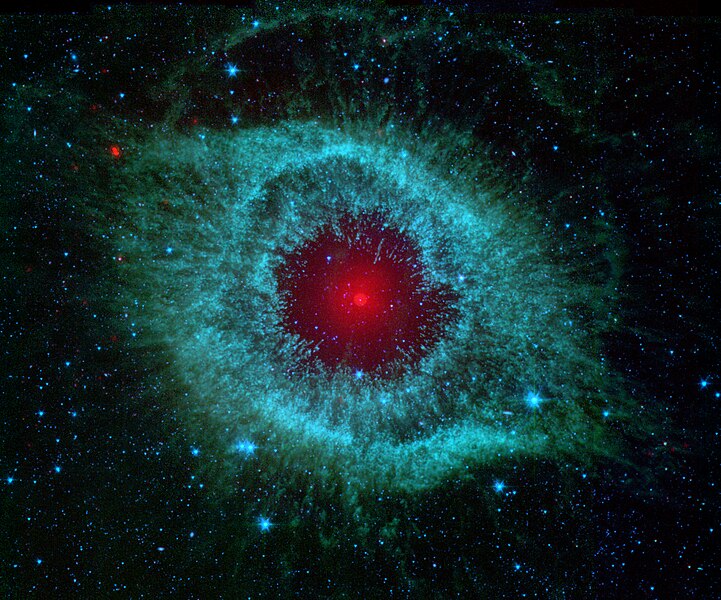Ӳкерчĕк:Comets Kick up Dust in Helix Nebula (PIA09178).jpg

Ҫак умкурӑмӑн виҫи: 721 × 600 пиксел. Ытти разрешенисем: 289 × 240 пиксел | 577 × 480 пиксел | 923 × 768 пиксел | 1231 × 1024 пиксел | 2462 × 2048 пиксел | 4279 × 3559 пиксел.
Оригиналлӑ файл ((4279 × 3559 пиксел, файл пысăкăше: 7,22 МБ, MIME-тĕсĕ: image/jpeg))
Файл историйĕ
Вӑхӑт ҫине пуссан, ун чухнехи версине пӑхма пулать.
| Дата/Вăхăт | Миниатюра | Калӑпӑш | Хутшăнакан | Асăрхав | |
|---|---|---|---|---|---|
| хальхи | 03:43, 13 Нарӑс уйӑхӗн 2007 |  | 4279 × 3559 (7,22 МБ) | Startaq | {{Information |Description=This infrared image from NASA's Spitzer Space Telescope shows the Helix nebula, a cosmic starlet often photographed by amateur astronomers for its vivid colors and eerie resemblance to a giant eye. The nebula, located about 700 |
Файлпа усă курни
Ку файлпа усӑ куракан страницӑсем ҫук.
Файлпа глобаллӑ усӑ курасси
Ку файлпа ҫак викисенче усӑ курнӑ:
- af.wikipedia.org усӑ курасси
- ar.wikipedia.org усӑ курасси
- arz.wikipedia.org усӑ курасси
- ast.wikipedia.org усӑ курасси
- ba.wikipedia.org усӑ курасси
- bg.wikipedia.org усӑ курасси
- bjn.wikipedia.org усӑ курасси
- bn.wikipedia.org усӑ курасси
- br.wikipedia.org усӑ курасси
- ca.wikipedia.org усӑ курасси
- cs.wikipedia.org усӑ курасси
- de.wikipedia.org усӑ курасси
- dsb.wikipedia.org усӑ курасси
- en.wikipedia.org усӑ курасси
- Helix Nebula
- Spitzer Space Telescope
- Comet nucleus
- Talk:Helix Nebula
- User:Swirlex/Userboxes
- User:Swirlex/Userboxcode
- NASA
- Wikipedia:Featured pictures/Space/Looking out
- User:Nonexyst
- User:Benjamin112
- Portal:Outer space/Selected picture
- User:Sunfishtommy/sandbox
- Wikipedia:Featured pictures thumbs/44
- Wikipedia:Featured picture candidates/October-2014
- User talk:Benison/Archive 19
- Wikipedia:Featured picture candidates/The God's Eye
- Wikipedia:Picture of the day/October 2016
- Template:POTD/2016-10-12
- Wikipedia:Main Page history/2016 October 12
- User talk:69.50.70.9
- User:The NMI User
- User:Corinne/subpage
- User talk:Benison/Archive 37
- Wikipedia:Userboxes/Science/Astronomy
- User:Catfurball
- User:Huggums537
Ку файлпа глобальлӗ епле усӑ курнине пӑх.



